
“Mr. Tambourine Man,” a timeless classic by The Byrds, remains a seminal track in the history of folk-rock. The Byrds, formed in Los Angeles in 1964, pioneered the genre by fusing the lyrical depth of folk music with the electrifying energy of rock and roll. Comprising Jim McGuinn (later Roger McGuinn), Gene Clark, David Crosby, Chris Hillman, and Michael Clarke, the band quickly rose to fame with their signature jangly guitar sound and distinctive vocal harmonies. Their impact was immediate, earning them a Grammy Hall of Fame award for “Mr. Tambourine Man” and consistent chart success throughout the mid-1960s, solidifying their position as a leading force in the burgeoning counterculture movement.
The song itself, penned by Bob Dylan, is an evocative plea to a mystical musician, the “Mr. Tambourine Man,” to transport the singer to a dreamlike state of freedom and escapism. It’s an invitation to lose oneself in music and experience a higher plane of consciousness, a theme resonating deeply with the psychedelic sensibilities of the era. While Dylan’s original version was a solo acoustic performance, The Byrds transformed it into a vibrant, electric anthem, injecting it with their signature 12-string Rickenbacker guitar and close harmonies.
Upon its release in 1965, “Mr. Tambourine Man” skyrocketed to the top of the Billboard Hot 100, becoming a defining sound of the summer. The public embraced its captivating melody and lyrical ambiguity. The song’s infectious optimism and yearning for escape struck a chord with listeners, particularly young people seeking alternative experiences and a break from societal norms. Critics lauded the band’s innovative arrangement and McGuinn’s distinctive vocals, recognizing it as a landmark achievement in the fusion of folk and rock, forever cementing The Byrds’ place in music history.